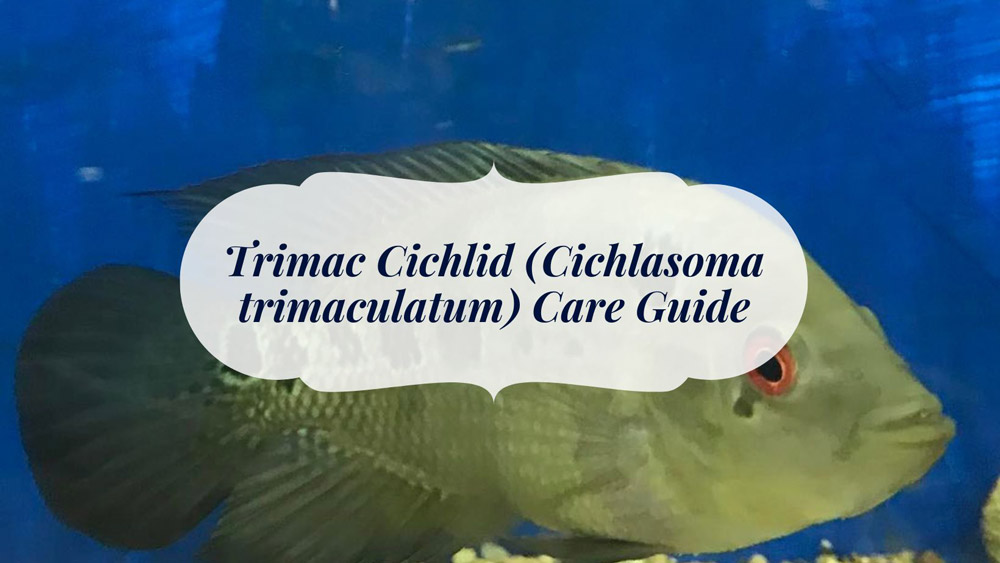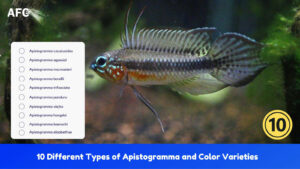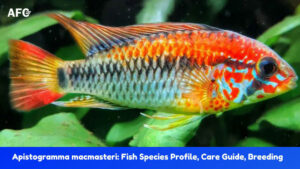Trimac Cichlid is rarely found as an aquarium fish, but they are widely famous for their brilliant appearance and massive size. These fish are easygoing and are popular among aquarists for their low-maintenance care requirements.
But even though caring for them is simple and hassle-free, we always encourage fishkeepers to know all essential facts about this species to keep them happy and healthy.
The comprehensive guide mentioned below will teach you everything you need to know about Trimac Cichlid care.
Species Summary
The Trimac Cichlid (Cichlasoma trimaculatum), also known as the three spot cichlid or red-eyed Cichlid, is native to Mexico and Central America.
Their natural habitats are lower valleys of the rivers of the Pacific Slope of Central America from Mexico to Panama. It has been found as an introduced species in Nevada and Florida, but these populations were extirpated.
This fish belongs to the genus Cichlasoma, a group of fish characterized by their large size, strong body, and multiple vertical black bars. There are currently 16 described species in the genus, although some taxonomists believe this number may be underestimated.
| Scientific Name: | Cichlasoma trimaculatum |
| Common Name: | Trimac Cichlid, red-eyed cichlid, three spot cichlid |
| Care Level: | Intermediate |
| Lifespan: | 12 years |
| Max Size: | Male: 14 inches; Female: 9-10 inches |
| Temperature: | 74 to 86°F |
| PH: | 6.5 – 7.5 |
| Water hardness: | 8 – 24 gH |
| Diet: | Carnivore |
| Minimum Tank Size: | Single Female: 55 gallons; Single Male: 125 gallons |
| Temperament: | Aggressive |
Appearance

The three spot cichlid is a heavy-bodied fish with a yellow or green hue base. It has distinct spots on its sides, making these species different from others. Males are much larger than females and have extended pointed fins, and they are relatively dark, with three bright spots on the dorsal fin.
Males Trimac cichlid also have red spots behind their gills and may grow a nuchal hump when nature. The female three spot cichlid, on the other hand, are generally lighter, with faint spotting on their dorsal fins. However, they can be dark at times as well.
As juveniles, Trimac cichlids are not very colorful, but they undergo a dramatic transformation as they mature. The adults are brightly colored, with males typically being more brilliantly hued than females.
Sexing Trimac cichlid can be tricky when they are still young, but their size difference is obvious as they grow – males grow larger than females. In addition, the female Trimac Cichlid has a black spot in the middle of the dorsal fin, whereas the male Trimac Cichlid is absent.
As always, the 100% accurate method to know the sex of your Trimacs is to wait until they are old enough and vent them.
Trimac Cichlid (Cichlasoma Trimaculatum) Size
The average size of the male Trimac Cichlid is around 14 inches, while females can grow up to 9-10 inches size. Since these species are larger, they should be kept in the giant aquarium, where they can find ample space for swimming.
The Trimac Cichlid is a fast-growing fish, one of the only species that can grow faster than an Oscar. When sold in stores, they are usually 2-3 inches in size, but the male Trimac Cichlid can go from 2 to 3 inches to 12 in about one year or less, while the female Trimac Cichlid will grow from 1 to 2 inches to 6 or 7 in about a year.
With proper care and a suitable environment, males will reach sexual maturity at 4.7–5.5 inches, while females can become mature at 3.1–3.9 inches, although individual differences always exist.
Several factors will influence the fully grown size of a Trimac cichlid. Some of these include genetic factors such as inherited traits and characteristics and environmental factors like nutrition, temperature, and habitat conditions.
Lifespan
Trimac Cichlid is rather one of the longest-living species out there. The average lifespan of three spot cichlid is around 12 years. However, the quality of care you provide also impacts their lifespan significantly.
Like all other species, they are also prone to health issues, and you should take optimal care of them to add more years to their life.
Trimac Cichlid Care
Although cichlasoma trimaculatum is easy to care for, we still recommend fishkeepers develop a solid knowledge base before adding them to their aquariums. Moreover, trimac Cichlid is known to be aggressive and grow to large sizes, so it’s a fish that is only recommended for experienced aquarists.
Follow the below-mentioned care guidelines and let your three spot cichlids thrive.
Tank Size
Since these fish can grow pretty large, they require ample space for swimming and hiding. A tank size of 55 gallons (48″ x 13″ x 21″) or more would be preferable for a single female Trimac Cichlid. For a single male, you should get a tank that will hold at least 125 gallons (72″ x 18″ x 21″).
Although this tank size is enough to keep them happy, a larger tank is appreciated to give Trimac some extra space. For a larger group, you need to bump up the tank size so that they can stay together without interfering with each other.
Water Parameters
The natural habitat of Trimac cichlids can vary in the wild. While most are found in slow-flowing rivers, and they prefer a muddy or sandy substrate where they hunt for small fishes, invertebrates, and insects among the submerged roots and weeds.
As a whole, they are very adaptable and can survive in freshwater environments. Stick to the below-mentioned water parameters that will work for most trimac cichlids.
- Water Temperature: 74 to 86°F
- pH: 6.5 – 7.5
- Hardness: 8 – 24 gH
- Ammonia: 0ppm
- Nitrite: 0ppm
- Nitrate: <30ppm
A strong water filtration system is a must to maintain these water parameters as Trimac cichlids are large fish and will produce a significant amount of waste; the Fluval FX4 with carbon filtration media is an ideal choice.
- Enhanced Performance: Multi-stage filter pumps out 700 US Gal (2,650 L) of water per hour, with the...
- Self-Starting: Just add water, plug in and Smart Pump technology will take over. Any trapped air is...
- Multi-functional Utility Valve: Drain at the base makes it possible to empty the canister and perform...
- 4-Stage Filtration: Four removable filter baskets eliminate water bypass and hold up to 1 US Gal (3.9 L)...
- Compact and Quiet Design: FX4 canister filter stands 16.5” (42 cm) tall and easily fits under most...
Sticking to an aggressive schedule of cleaning/water changes (50% weekly) will be the most important thing to help your fish be more comfortable and grow as large as possible.
Plants & Substrate

If you are adding three spot cichlid to your aquarium, make sure to replicate the environment as much as possible. The tank should be set up with stones, roots, and driftwoods, that make hiding places.
We don’t recommend including any aquarium plants as Trimac Cichlid are known to uproot them. You can add rocks and bogwood to form their territories. Like other cichlids, trimacs love rearranging the tank decor based on their preferences, so be ready to witness slight changes afterward.
Since they are primarily found in slower-moving water, avoid strong currents in the aquarium. These fish also will appreciate a soft, sandy substrate in their tank. In addition to the substrate, do not forget to add dim lighting to spot their true beauty.
Food & Diet
Trimac Cichlid is a fiercely predatory carnivore that feeds on a variety of smaller fish and small terrestrial and aquatic insects in its natural habitat.
In captivity, their diet should consist of a wide variety of foods. You can feed them some protein-rich snacks like fresh shrimp, bloodworms, tubifex, Mysis shrimps, and earthworms to give them a well-rounded diet.
In addition to this, you can also supplement Trimac’s diet with fresh veggies like cucumber, zucchini, and peas.
High-quality pellets or flakes are a great staple that we highly recommend. The most affordable choice is Hikari Cichlid Gold, a growth and color enhancing large pellet that is perfect for bigger Cichlid with a large mouth and appetite.
- Floating pellets allow easy monitoring of amount eaten
- Will not cloud water
- High in beta carotene and NS Germ, brings out natural brilliant colors
- Promotes long healthy life
- Contains stabilized vitamin C
New Life Spectrum 2kg tub (3mm) has been voted the number 1 fish food by the community. A great all-around fish pellet, this formula is made with natural ingredients that are designed to bring out the best in your Trimac Cichlid’s coloration. However, it will hurt your wallet a bit when your fish gets large.
Behavior & Compatibility
Trimac Cichlids are pretty aggressive towards other species and will not tolerate other tankmates easily. Therefore, it is recommended to keep them alone if your tank is on the smaller side. One male Trimac Cichlid alone or a pair are two common choices.
It is possible to keep this specie with other fish in community tanks. But you need to be careful. Only choose the robust Central and South American Cichlids that can take a bit of abuse from them.
Some of the suitable tankmates for Trimac Cichlid include larger species:
- Convict Cichlid (Size | Lifespan | Sexing)
- Firemouth Cichlid (Size)
- Chocolate Cichlid (Hypselecara temporalis)
- Uaru Cichlid (Uaru amphiacanthoides)
Breeding
They are reasonably easy to breed. However, obtaining a true Trimac cichlid is really hard as most of them available in pet stores are hybrid flowerhorn cichlid.
If you’re lucky enough to find a reliable source, you can purchase a group of 6-8 juvenile fish and allow them to grow. After they are fully grown, the Trimac cichlids will pair off and lay eggs on a flat surface.
The Trimac Cichlid is an egg-laying species; a female can even lay more than 1000 eggs, depending on the size.
Once the eggs have been laid, the male will fertilize them, and then both parents will then carefully guard the eggs until they hatch. When the fry are free swimming, they can be fed on a diet of baby brine shrimp and finely ground pellets.
Availability
A true Trimac Cichlid (Cichlasoma Trimaculatum) is rarely found both online and in local fish stores, so you can expect to pay a hefty sum for one. Trimacs are more often bred with other Flowerhorn cichlids and sold as hybrids in the pet trade.
If you want a Trimac Cichlid but do not want to spend that much money, there are some Trimac hybrids available in the market that cost less. These Trimac hybrids are bred by crossing a Trimac with another Flowerhorn cichlid.
Just remember, before purchasing a Trimac cichlid, make sure to do your research and purchase your fish from a reputable source to avoid any disappointment.
Final Thoughts
Even though Trimac cichlids are fairly rare, they are becoming more and more popular among fish enthusiasts due to their unique coloration and aggressive nature. If you are looking for a beautiful fish with a unique personality, then the Trimac Cichlid is a perfect choice.
We hope our in-depth guide will assist you in keeping this massive fish in your aquarium. Having this beautiful species in your tank is a rewarding experience. They are fun to watch and look like absolute centerpieces when kept in home aquariums.
If you have any questions or comments, feel free to share them in the comment section below! We love hearing from you.
Good luck!








